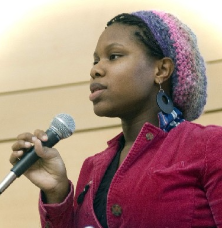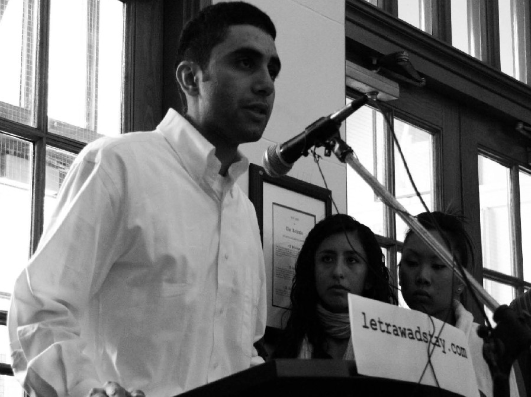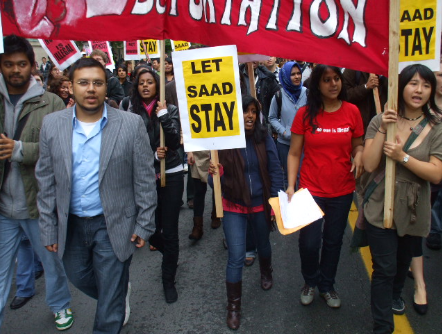York U pilot project raises questions about the U of O’s efforts to accommodate precarious status students
Kimberly and Gerald Lizano-Sossa. Matthew Nguyen. Rawad Reda. Sarah Leonty. Saad Alam. You might be wondering, what do these names, and the individuals behind them, have in common?
Though each individual story is different, they represent a small handful of Canada’s precarious or non-status immigrants who met massive hurdles in simply accessing post-secondary education while living in Canada.
It was organizing around Leonty’s case in 2008 that put the issue front and centre at York University in Toronto. Nine years later, York has introduced a pilot program that seeks to ease the cost barrier by offering domestic fees to 10 non-status immigrants.
But, as with any new program, important questions arise—will this be enough? And if successful, could this model be replicated at other institutions like the University of Ottawa?

Sarah Leonty’s case drew attention to the exclusionary nature of international fees. Photo: Provided by David Moffette.
Understanding the “apartheid” of education
Only 11 years old when she arrived in Canada from St. Lucia, Leonty had lived in Toronto for most of her life. In 2008 she was set to enter her second year at York University, when the institution discovered she could be classified as an international student due to her parents’ precarious status.
When Leonty realized she couldn’t pay the international student fees, which were significantly higher than what she had been paying in her first year, she was unable to continue her schooling. This meant that she would lose her student visa, and be deported to St. Lucia—a place she hadn’t set foot in since age 11. Eventually, with pressure from the student body, York made an exception for Leonty.
Although public pressure succeeded in this case, it was demonstrative of what David Moffette, a U of O professor of criminology, calls a type of “apartheid.”
A long-time participant in Toronto’s access to education movements, he says that a major issue for immigrants trying to obtain a post-secondary education is that a “dual law” comes into play.
“If you have permanent residency, you pay domestic fees, so that’s thousands and thousands and thousands of dollars less,” he says. “Basically any other immigrant who is non-status is treated as international, not entitled to paying domestic fees, and having to pay a very important premium.”
At the U of O, for example, for an undergraduate student working towards a bachelor of arts, the international fee for tuition is over $10,000 more per term than the domestic fee.
Patti Lenard, a professor at the U of O’s Graduate School of Public and International Affairs, notes that this kind of premium can pose a challenge to non-status immigrants as they might not have enough money to fund their education—as seen in Leonty’s case.
“You don’t want anyone paying international fees, because international fees are very high. So the biggest barrier to education, especially university education, is cost,” says Lenard. “What all universities should do is abolish international fees, but they can’t do that because … the provincial government, the way they fund universities rewards the university for choosing domestic students.”
As well, while provincial government spending to universities has in fact decreased, this has been paired with a pointed increase in international student fees in Ontario. Taken together, international students have become an important source of funding for universities, at the expense of equal access.

Rawad Reda gained much support while facing deportation to Lebanon. Photo: Provided by David Moffette.
Barriers start, but don’t end, with cost
It was in 2006 that Reda was served with a deportation order, after graduating from Toronto’s Jarvis Collegiate Institute and gaining acceptance to Georgian College for the fall term. His study permit was rejected with no reason given, and he was told to leave Canada voluntarily to Aita el Chaab, a village in Lebanon where he had no immediate family and that was mostly destroyed by bombings.
Reda was told that enforcement actions would be taken if he didn’t leave voluntarily. But with the support of teachers, friends, and activists, the Minister of Citizenship ultimately chose to extend his study permit so that he could attend college.
While cost is an important factor in the struggle for access, it’s evidently not the whole story. Lenard says that the most pressing issue, alongside the question of education, is the available legal protection.
She notes important questions to ask, such as “can we get them legal help, to make a better case in order for them to stay? Can we find ways to prove to the Canadian government or immigration that they have a right to stay?”
Moffette believes that it’s not just the money that matters, but the way the immigration system limits access to other services related to schools, such as sports activities and libraries.
“I don’t think we can separate success at school from the other parts of our life,” he says. “Having trouble finding good work, and paying for school, and all of this, I think hinders people’s capacity to be successful in school.”
“I think we in Canada exclude discrimination that international students face in general from the discussion.”

Despite protests held on U of T campus, Saad Alam was deported to Bangladesh in the middle of his term. Photo: Provided by David Moffette.
Can the U of O put an end to the precarity?
In September 2008, Alam was attending the University of Toronto when his application for status was rejected, and he was ordered to be removed from his studies. Although other students rallied in his defence and called for the university to intervene, the U of T remained silent while Alam was deported alongside his family mid-semester.
The Ontario Education Act indicates that everyone, no matter their status, has a right to education until age 18. However, no similar provincial policy exists to ensure that students older than 18 can equally access university or college education regardless of socioeconomic background or immigration status.
According to Moffette, this can leave people stuck in limbo due to their precarious status.
“It’s important that people who come here on a work visa but they’re not able to renew their work visa, people who come here as asylum seekers and eventually their claim is denied, people moving here with their parents renewing a short-term visa, I believe they should have access like anybody else to has access to services.”
To this end, York has put 10 students on equal footing with domestic students—for now. An important caveat in this program is that funding for these students is only secured for this year, meaning that if the donations to York don’t pan out as anticipated, or new priorities for the university arise, they could be thrown into a tricky situation similar to Leonty’s.
But with many of the same issues facing students at the U of O, can our university learn from York’s trial run and implement a better program?
When faced with this question, U of O media relations manager Néomie Duval noted that the York program is comparable to the U of O’s differential tuition fee exemption program. This program allows international students to pay domestic fees, provided that they meet the eligibility criteria. For undergraduate programs, this includes being enrolled full-time in a program offered in French with a minimum of three courses in French per term.
On the other hand, under this program graduate students must be enrolling in a degree that is offered only in French, or have a secondary or postsecondary diploma in French equivalent to a minimum of two years of study.
To maintain the fee exemption, both undergraduate and graduate students cannot study part-time during their degree, with the exception of the summer term.
The implication of this is that international students who access their education through the program cannot reduce their course load in the event of health issues, in order to serve in their student federation executive (as executive members are required to be part-time), or simply to work while studying in order to pay for basic expenses such as rent, tuition, and textbooks.
Clearly, both the York and U of O systems are well-intentioned, but ultimately leave international students at a disadvantage relative to domestic students and students with permanent residency. Moffette says that for Ottawa, and beyond, this needs to change.
“If we’re sharing the same workplaces, the same society, the same city, people should have similar and equal access to all services. And education is one of them.”

Gerard (left) and Kimberly Lizano-Sossa were removed from their high school and deported to Costa Rica. Photo: Provided by David Moffette.
Demanding institutional change
Moffette says that it’s important to note that York University might not have even started their program if Leonty and her supporters hadn’t made so much noise around the issue in 2008. This underlines the fact that, even if university administrations remain silent on challenges around precarious status, action from the university community—including teaching staff, students, campus clubs, and more—can go a long way.
Matthew Nguyen, Rawad Reda, and Sarah Leonty were all able to pursue their education, despite precarious status, due to the public outcry around their cases. The movements around these students all began in their respective school systems, and this is a commonality that’s hard to ignore.
While post-secondary schools have begun to take strides in what Moffette says is the “right direction,” if these institutions are serious about easing the barriers to access, it’s imperative to evaluate whether the programs themselves are introducing even more precarity to the situation.
In the case of York, will these 10 students begin their studies this year, only to find themselves without funding for the second, third, or fourth year? At the U of O, will students enrol with fee exemption, only to be faced with a health issue that prevents them from studying full-time, and therefore lose their exemption? If students at both universities find themselves unable to pay the extra fees that result, what does that mean for their visa?
While hypothetical, these are important questions, and very possible realities, that neither program seems to have considered. But if universities want to wear the badge of assisting non-status immigrants, they must consider the very real barriers that their advertised benefits may pose.
As Moffette says, “There’s no way we can provide good education if we don’t provide education that is accessible to anyone who wants to get an education.”
It’s time to bring good education back to the U of O.





